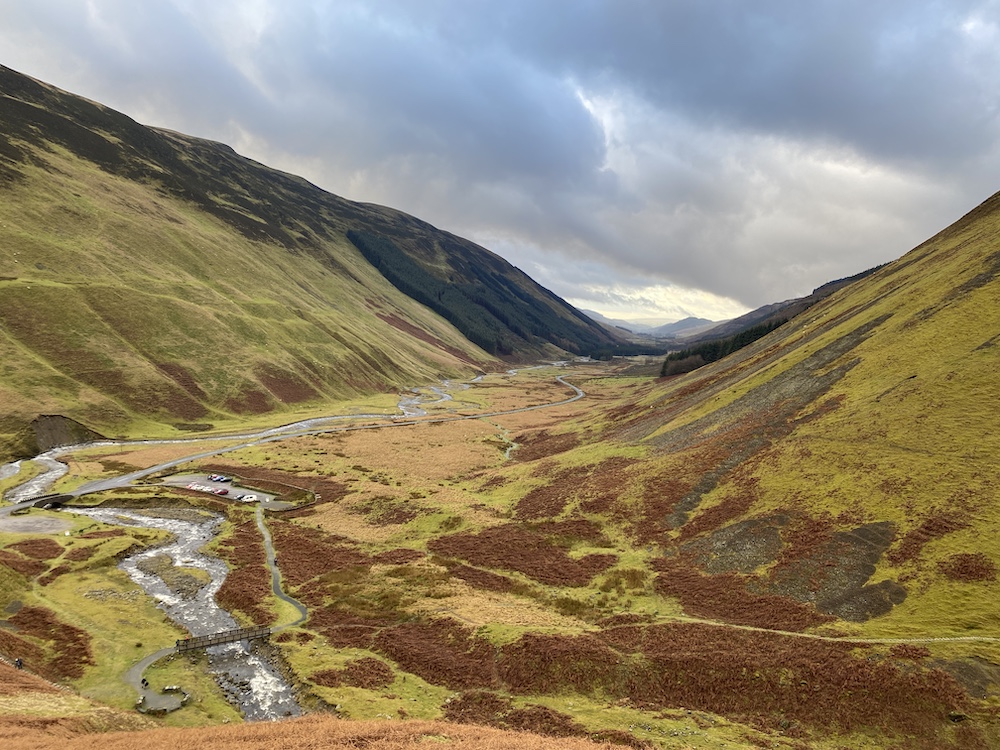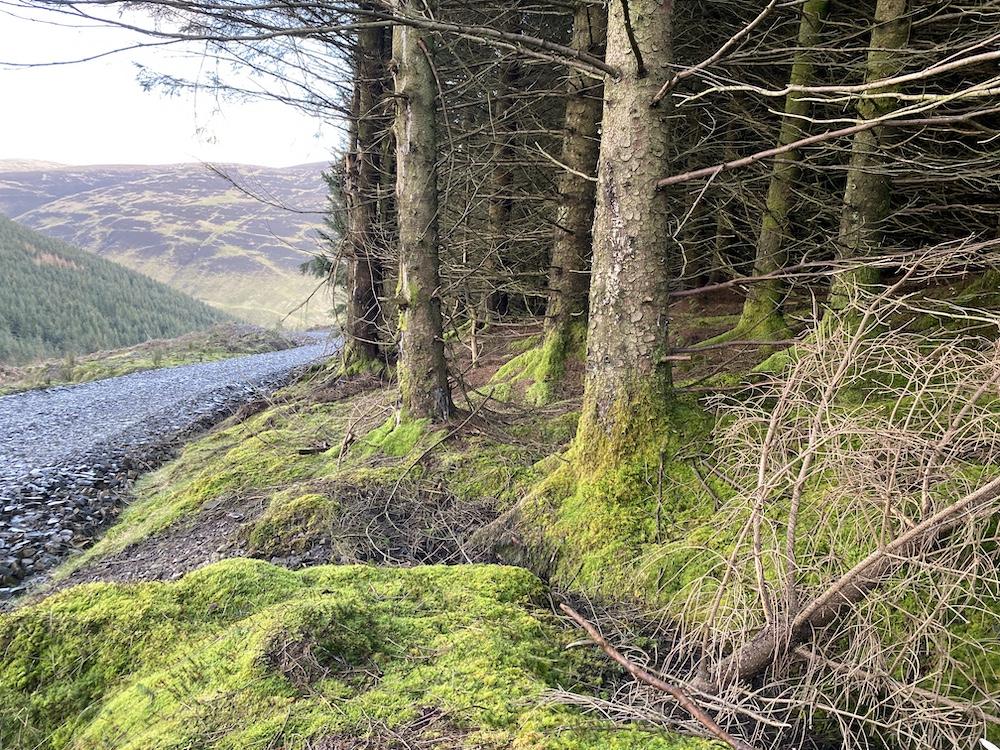I am not obsessed with summit bagging (well, perhaps only a little) but I do love a walk in a new place, with a friend (or friends) and with wonderful views. A circular hike of almost 20km from Grey Mare’s Tail, near Moffat, and in the hills of southern Scotland proved to be a great treat at the weekend.
Ben and I had been desperately searching for a patch of sunshine in a country-wide forecast that appeared to be only rain, clouds and high winds. We spotted a glimmer of hope for Sunday morning in Dumfries & Galloway and planned a walk to tick off a few summits.
The Corbett, White Coombe (821m), and Donald Lochcraig Head (801m) would be new to me, while Ben was keen to retrace his previous steps and extend the route to take in three Donald Tops.
Ben had started his hill bagging career with Donalds and Grahams, and has now joined me in my pursuit of the Corbetts.


What is a Donald?
The Donalds are named after Percy Donald and are identified as hills over 2000ft in the Scottish Lowlands. They are based on a rather complicated formula for determining separate hills. They originally comprised 87 hills, plus a number of other named “tops”.
There are also the “New Donalds”, which are an attempt to rationalise the qualifying criteria, being “hills in central or southern Scotland at least 2000ft high (610m) with a drop of at least 30 metres (98 feet) all round”.
All New Donalds are either a Donald or a Donald Top, but some of the Donald Tops do not qualify as New Donalds.
It seems rather confusing to me and I have decided not to worry about the Donalds or the Donald Tops. However, Ben was keen to extend a circuit of White Coombe to reach a few Donald Tops and I was happy to oblige.
What is a Corbett?
The Corbetts are the mountains in Scotland between 2500ft (609m) and 3000ft (914.4m) high, with at least 500ft (152m) of descent on all sides.
The first list was compiled in the 1920s by John Rooke Corbett, a climber and Scottish Mountaineering Club (SMC) member from Bristol. The Corbetts list was published posthumously, after John’s sister passed it to the SMC, in the 1953 edition of Munro’s Tables.


A walk in the southern hills
Ben and I started at the NTS car park for Grey Mare’s Tail. There is a stone-built path that climbs steeply up the right-hand side of the dramatic waterfall and we passed many visitors who had simply walked to the top of the 60m hanging valley.
A couple of men, who were buzzing with adrenaline, told us they had been to the top to swim in Loch Skeen. “It was 4.2C,” one said. “That’s quite warm actually.” I felt cold just thinking about it but they were clearly very happy about their swim.
It did not take long to reach the same loch and suddenly the views opened up with the high hills creating a beautiful backdrop to the dark, chilly looking waters. The southern end of Loch Skeen cascades into a fast-flowing river that then plummets into the water of Grey Mare’s Tail. I can imagine in summer that this is an idyllic spot.
On a winter’s day, the wind created small white horses on the water and as we started to climb higher on the eastern side of the loch, we could feel the cold air rushing around our heads.
My wrists became chilled and I noticed a small gap between my gloves and jacket sleeve. As we walked and talked, and stop for breathers because the ascent was fairly steep, we met more people also climbing the hill.
Over many recent outings to the Corbetts, Ben and I have rarely met another person but it seemed that everyone had decided, just like we had, that the Moffat hills would be the best bet for fair-ish weather.
The climb continued steeply for close to a kilometre and I was annoyed that today of all days, I had forgotten my walking poles. Ben kindly shared his but ascending with one pole is nowhere near as helpful as with two poles.
See my running and walking poles review.

A Donald and a Donald Top
Lochcraig Head was located close to the top of the steep climb and I touched the cairn before we checked the map. By now we were walking in mist and low clouds and the wind was strong.
At intervals it also started to snow. It was the kind of mean and prickly snow that hurts as it hits the skin and eyes.
To stay on course, we chose to follow the line of two fences. These were clearly marked on the map and they were very easy to spot on land.
I questioned Ben’s sanity as we walked into the wind and snow towards a Donald Top named Nickies Knowe. (“It doesn’t even have an apostrophe,” I bitched to myself!). Yet Ben is a good friend and if he fancied extending the walking route to pick up an obscure summit top then I was happy to humour him.
As luck would have it, as we neared the (tiny) cairn, the clouds thinned and parted and we were treated to splendid views over the rolling countryside of southern Scotland and across to another stunning water, Talla Reservoir.
It was wonderful to see the extent of the different glens in this part of the country.
While I am not planning to become a keen bagger of Donalds and Donald Tops, I can see some advantages to this list. We ended up walking away from the groups of other walkers and had many kilometres of hills to ourselves.


A little contouring
The options were to retrace our steps – we would have done so it the mist had thickened – or to contour around the hill we had just climbed. The aim was to return to the path that most people follow to reach White Coombe.
At a bealach high above the northern end of Loch Skeen, we climbed steeply again. We met more walkers and they asked where we had come from. I probably told Ben I would not mention his strange Donald Top’s obsession but I couldn’t help myself.
“Oh, we’ve just been off that way some 2kms to walk to a summit with a tiny cairn. Ben is collecting tops. The views were nice though,” I told them. Sorry Ben!
Pushing upwards, we reached another section of flatter moorland. It was green and boggy and reminded me of my usual running territory in the Campsies and Kilpatricks close to Glasgow.

A DT, Corbett and DT
Passing another couple of walkers, we could only manage a quick grunt of a hello because the wind was driving pointed sleety snow into the side of our faces.
I was wearing an extra layer of insulated jacket and two pairs of gloves to stay warm.
After a few undulations we reached another DT, Firthhope Rig, before the Corbett of the day, White Coombe. I was sad that we did not have a view but it did feel satisfying to tick off another in my list of Cs. That’s 29 to date and many hiked in the past 12 months.

At the Corbett summit, we needed to decide if we would march quickly off the hill and back to the car park, or follow another detour to another Donald Top.
Neither of us felt particularly fatigued so we decided to detour. Again, we walked into a headwind and sleet. I managed to shape the wired hood of my waterproof jacket to shelter my eyes from the pinpricks of the snow and I pulled a buff up over most of my face.
It wasn’t all grim, though, because we continued to chat amiably and in between the snow showers the views were beautiful.

Carrifan Gans, the final DT, seemed to arrive quite quickly and Ben was delighted to get another tick.
When he started the Donalds, he had not included the Donald Tops so he is now returning to the summits to complete his full list. I admire his determination.

Completing the loop
Because we were following a circuit, we enjoyed views of the south-eastern flanks of White Coombe. Most people head due east descending via “Rough Craigs” to return to the Great Mare’s Tail carp park, but we descended towards forestry further south.
The corries on the southern side of White Coombe are beautiful.
We edged into the forest plantation and picked up a wide track that swept east and then south-west. It was not a direct route but it did offer the best views. The views along the glen in the lowering sun were superb.
We also spotted two of the fabled feral goats that roam the hills in this area.


Towards the end of the walk, Ben and I joined the A708 road and walked along the edge of the tarmac for almost 2kms. It felt like a long way back to the car park as we closed in on a route of 20km (12 miles) but at least it was mostly downhill.
As we walked, we could see a steady stream of people going up and down the steep path at the side of Grey Mare’s Tail. The car park was surprisingly busy at mid-afternoon on a dodgy weather day in January. Presumably, everyone else had taken their chances with the conditions, too.

We felt as thought we had got lucky for our long walk in the fabulous Scottish Borders.
